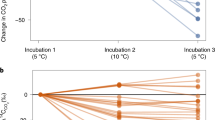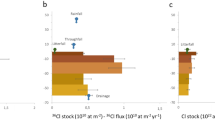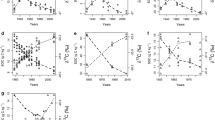Abstract
This article reports the design of 13C-dating, the first method to calculate the relative age of molecular substance homologues occurring in fractions from the same soil sample. Soil is a major carbon pool impacting modern climate by CO2 release and uptake. Molecular substances that sequester carbon in soils are poorly known due to the absence of methods to study molecular-level C dynamics over agricultural time scales, e.g., 0–200 years. Here, I design a method to calculate the relative age of the plant-derived C31 n-alkane occurring in 6 fractions from a soil sample naturally 13C-labelled by maize cropping during 23 years. Soil fractions are the bulk soil extract, two humin-encapsulated fractions and three particle-size fractions. Results show that C31 n-alkane homologues have relative ages ranging from −6.7 years for the humin-encapsulated homologue to +25.1 years for the 200–2,000-μm fraction homologue. Such a wide variation of 31.8 years evidences temporal pools of molecular substances in soil. This finding also reveals that physical encapsulation can strikingly change the dynamics of a single molecular substance. 13C-dating thus allows to assess the carbon storage potential of molecular substances from crop soils. Such knowledge will help to identify molecular compounds, associated soil pools and agricultural practices that favour carbon sequestration. 13C-dating is further applicable to any environmental sample containing organic matter subjected to a 13C isotope shift with time. 13C-dating will also help to study the sequestration and delayed release of chemicals in various disciplines, such as pollutants in environmental sciences, pharmaceuticals in medicine, and nutrients in food science.



Similar content being viewed by others
References
Alletto L, Coquet Y, Benoit P, Heddadj D, Barriuso E (2010) Tillage management effects on pesticide fate in soils. A review. Agron Sustain Dev 30:367–400. doi:10.1051/agro/2009018
Barriuso E, Benoit P, Dubus IG (2008) Formation of pesticide nonextractable (bound) residues in soil: magnitude, controlling factors and reversibility. Environ Sci Technol 42:1845–1854. doi:10.1021/es7021736
Barth JAC, Grathwohl P, Fowler HJ, Bellin A, Gerzabek MH, Lair GJ, Barceló D, Petrovic M, Navarro A, Négrel Ph, Petelet-Giraud E, Darmendrail D, Rijnaarts H, Langenhoff A, de Weert J, Slob A, van der Zaan BM, Gerritse J, Frank E, Gutierrez A, Kretzschmar R, Gocht T, Steidle D, Garrido F, Jones KC, Meijer S, Moeckel C, Marsman A, Klaver G, Vogel T, Bürger C, Kolditz O, Broers HP, Baran N, Joziasse J, Von Tümpling W, Van Gaans P, Merly C, Chapman A, Brouyère S, Batlle Aguilar J, Orban Ph, Tas N, Smidt H (2009) Mobility, turnover and storage of pollutants in soils, sediments and waters: achievements and results of the EU project AquaTerra. A review. Agron Sustain Dev 29:161–173. doi:10.1051/agro:2007060
Benbi DK, Brar JS (2009) A 25-year record of carbon sequestration and soil properties in intensive agriculture. Agron Sustain Dev 29:257–265. doi:10.1051/agro/2008070
Bull ID, van Bergen PF, Nott CJ, Poulton PR, Evershed RP (2000) Organic geochemical studies of soils from the Rothamsted classical experiments—V. The fate of lipids in different long-term experiments. Org Geochem 31:389–408. doi:10.1016/S0146-6380(00)00008-5
Cayet C, Lichtfouse E (2001) δ13C of plant-derived n-alkanes in soil particle-size fractions. Org Geochem 32:253–258. doi:10.1016/S0146-6380(00)00172-8
Doumbia M, Jarju A, Sène M, Traoré K, Yost R, Kablan R, Brannan K, Berthe A, Yamoah C, Querido A, Traoré PCS, Ballo A (2009) Sequestration of organic carbon in West African soils by Aménagement en Courbes de Niveau. Agron Sustain Dev 29:267–275. doi:10.1051/agro:2008041
Fang Z, Bhandari B (2010) Encapsulation of polyphenols–a review. Trends Food Sci Technol 21:510–523. doi:10.1016/j.tifs.2010.08.003
Freier K, Glaser B, Zech W (2010) Mathematical modeling of soil carbon turnover in natural Podocarpus forest and Eucalyptus plantation in Ethiopia using compound specific δ13C analysis. Global Change Biol 16:1487–1502. doi:10.1111/j.1365-2486.2009.02096.x
Gleixner G, Poirier N, Bol R, Balesdent J (2002) Molecular dynamics of organic matter in a cultivated soil. Org Geochem 33:357–366. doi:10.1016/S0146-6380(01)00166-8
Halberg N, Hermansen JE, Kristensen IS, Eriksen J, Tvedegaard N, Petersen BM (2010) Impact of organic pig production systems on CO2 emission, C sequestration and nitrate pollution. Agron Sustain Dev 30:721–731. doi:10.1051/agro/2010006
Harkness DD, Harrison AF, Bacon PJ (1986) The temporal distribution of ‘bomb’ 14C in a forest soil. Radiocarbon 28:328–337
Hazarika S, Parkinson R, Bol R, Dixon L, Russell P, Donovan S, Allen D (2009) Effect of tillage system and straw management on organic matter dynamics. Agron Sustain Dev 29:525–533. doi:10.1051/agro/2009024
Hedges JI, Oades JM (1997) Comparative organic geochemistries of soils and marine sediments. Org Geochem 27:319–361. doi:10.1016/S0146-6380(97)00056-9
Hedges JI, Eglinton G, Hatcher PG, Kirchman DL, Arnosti C, Derenne S, Evershed RP, Kögel-Knabner I, de Leeuw JW, Littke R, Michaelis W, Rullkötter J (2000) The molecularly-uncharacterized component of nonliving organic matter in natural environments. Org Geochem 31:945–958. doi:10.1016/S0146-6380(00)00096-6
Huang Y, Eglinton G, Ineson P, Latter PM, Bol R, Harkness DD (1997) Absence of carbon isotope fractionation of individual n-alkanes in a 23-year field decomposition experiment with Calluna vulgaris. Org Geochem 26:497–501. doi:10.1016/S0146-6380(97)00027-2
Knicker H, Hatcher PG (1997) Survival of protein in an organic-rich sediment: possible protection by encapsulation in organic matter. Naturwissenschaft 84:231–234. doi:10.1007/s001140050384
Kubicki JD, Apitz SE (1999) Models of natural organic matter and interactions with organic contaminants. Org Geochem 30:911–927. doi:10.1016/S0146-6380(99)00075-3
Lal R (2010) Soils as source and sink of environmental carbon dioxide. In: Xu J, Huang PM (eds) Molecular environmental soil science at the interfaces in the earth’s critical zone. Springer, Berlin, pp 11–12. doi:10.1007/978-3-642-05297-2_3
Lichtfouse E (1995) 13C Labelling of soil n-hentriacontane (C31) by maize cultivation. Tetrahedron Lett 36:529–530. doi:10.1016/0040-4039(94)02305-U
Lichtfouse E (1997) Heterogeneous turnover of molecular organic substances from crop soils as revealed by 13C labeling at natural abundance with Zea mays. Naturwissenschaft 84:23–25. doi:10.1007/s001140050342
Lichtfouse E (1999) Temporal pools of individual organic substances in soil. Analusis 27:442–444. oai:hal.archives-ouvertes.fr:hal-00262449. http://hal.archives-ouvertes.fr/hal-00262449/fr/
Lichtfouse E (2000) Compound-specific isotope analysis (CSIA), application to archaeology, biomedical sciences, biosynthesis, environment, extraterrestrial chemistry, food science, forensic science, humic substances, microbiology, organic geochemistry, soil science and sport. Rapid Commun Mass Spectrom 14:1337–1344. doi:10.1002/1097-0231(20000815)14:15<1337:AID-RCM9>3.0.CO;2-B
Lichtfouse E, Chenu C, Baudin F, Leblond C, Da Silva M, Behar F, Derenne S, Largeau C, Wehrung P, Albrecht P (1998a) A novel pathway of soil organic matter formation by selective preservation of resistant straight-chain biopolymers: chemical and isotope evidence. Org Geochem 28:411–415. doi:10.1016/S0146-6380(98)00005-9
Lichtfouse E, Wehrung P, Albrecht P (1998b) Plant wax n-alkanes trapped in soil humin by noncovalent bonds. Naturwissenschaft 85:449–452. doi:10.1007/s001140050529
Lichtfouse E, Navarrete M, Debaeke P, Souchère V, Alberola C (2009) Sustainable agriculture. Springer, Netherlands, p 919. doi:10.1007/978-90-481-2666-8
Lichtfouse E, Hamelin M, Navarrete M, Debaeke P, Henri A (2010) Emerging agroscience. Agron Sustain Dev 30:1–10. doi:10.1051/agro/2009055
Lichtfouse E, Hamelin M, Navarrete M, Debaeke P (2011) Sustainable agriculture volume 2. Springer, Netherlands, p 991. doi:10.1007/978-94-007-0394-0
Marschner B, Brodowski S, Dreves A, Gleixner G, Gude A, Grootes PM, Hamer U, Heim A, Jandl G, Ji R, Kaiser K, Kalbitz K, Kramer C, Leinweber P, Rethemeyer J, Schäffer A, Schmidt MWI, Schwark L, Wiesenberg GLB (2008) How relevant is recalcitrance for the stabilization of organic matter in soils? J Plant Nutr Soil Sci 171:91–110. doi:10.1002/jpln.200700049
Mazeas L, Budzinski H, Raymond N (2002) Absence of stable carbon isotope fractionation of saturated and polycyclic aromatic hydrocarbons during aerobic bacterial biodegradation. Org Geochem 33:1259–1272. doi:10.1016/S0146-6380(02)00136-5
Mishra B, Patel BB, Tiwari S (2010) Colloidal nanocarriers: a review on formulation technology, types and applications toward targeted drug delivery. Nanomed Nanotech Biol Med 6:9–24. doi:10.1016/j.nano.2009.04.008
Novak SM, Fiorelli JL (2010) Greenhouse gases and ammonia emissions from organic mixed crop-dairy systems: a critical review of mitigation options. Agron Sust Dev 30:215–236. doi:10.1051/agro/2009031
Ohkouchia N, Eglinton R (2008) Compound-specific radiocarbon dating of Ross Sea sediments: a prospect for constructing chronologies in high-latitude oceanic sediments. Quat Geochronol 3:235–243. doi:10.1016/j.quageo.2007.11.001
Pati FM, Clay DE, Carlson G, Clay SA (2010) Non-isotopic and 13C isotopic approaches to calculate soil organic carbon maintenance requirement. In: Lichtfouse E (ed) Sociology, organic farming, climate change and soil science. Sustain Agric Rev 3:189–215. doi:10.1007/978-90-481-3333-8_8
Pearson A, Eglinton TI (2000) The origin of n-alkanes in Santa Monica basin surface sediment: a model based on compound-specific Δ14C and δ13C data. Org Geochem 31:1103–1116. doi:10.1016/S0146-6380(00)00121-2
Pearson A, McNichol AP, Benitez-Nelson BC, Hayes JM, Eglinton TI (2001) Origins of lipid biomarkers in Santa Monica Basin surface sediment: a case study using compound-specific Δ14C analysis. Geochim Cosmochim Acta 65:3123–3137. doi:10.1016/S0016-7037(01)00657-3
Rubino M, Dungait JAJ, Evershed RP, Bertolini T, De Angelis P, D’Onofrio A, Lagomarsino A, Lubritto C, Merola A, Terrasi F, Cotrufo MF (2010) Carbon input belowground is the major C flux contributing to leaf litter mass loss: evidences from a 13C labelled-leaf litter experiment. Soil Biol Biochem 42:1009–1016. doi:10.1016/j.soilbio.2010.02.018
Schnitzer M (1991) Soil organic matter—the next 75 years. Soil Sci 151:41–58
Sohi SP, Krull E, Lopez-Capel E, Bol R (2010) A review of biochar and its use and function in soil. Adv Agron 105:47–82. doi:10.1016/S0065-2113(10)05002-9
Stavi I, Lal R (2011) Challenges and opportunities of soil organic carbon sequestration in croplands. In: Lichtfouse E (ed) Biodiversity, Biofuels, Agroforestry and conservation agriculture. Sust Agric Rev 5:149–174. doi:10.1007/978-90-481-9513-8_5
Sun Y, Chen Z, Xu S, Cai P (2005) Stable carbon and hydrogen isotopic fractionation of individual n-alkanes accompanying biodegradation: evidence from a group of progressively biodegraded oils. Org Geochem 36:225–238. doi:10.1016/j.orggeochem.2004.09.002
Sutton R, Sposito G (2005) Molecular structure in soil humic substances: the new view. Environ Sci Technol 39:9009–9015. doi:10.1021/es050778q
Trumbore S (2000) Age of soil organic matter and soil respiration: radiocarbon contraints on belowground C dynamics. Ecol Appl 10:399–411. doi:10.1890/1051-0761(2000)010[0399:AOSOMA]2.0.CO;2
Wan Y, Amundson R, Trumbore S (1996) Radiocarbon dating of soil organic matter. Quat Res 45:282–288
Wiesenberg GLB, Jan Schwarzbauer J, Schmidt MWI, Schwark L (2004) Source and turnover of organic matter in agricultural soils derived from n-alkane/n-carboxylic acid compositions and C-isotope signatures. Org Geochem 35:1371–1393. doi:10.1016/j.orggeochem.2004.03.009
Author information
Authors and Affiliations
Corresponding author
Rights and permissions
About this article
Cite this article
Lichtfouse, E. 13C-dating, the first method to calculate the relative age of molecular substance homologues in soil. Environ Chem Lett 10, 97–103 (2012). https://doi.org/10.1007/s10311-011-0334-2
Received:
Accepted:
Published:
Issue Date:
DOI: https://doi.org/10.1007/s10311-011-0334-2




